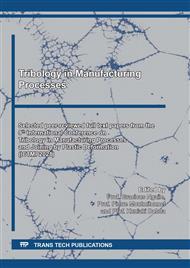p.125
p.133
p.139
p.147
p.155
p.163
p.169
p.179
p.185
Investigation on the Influence of the Tribological System on Cold Forging and Ejection of Hollow Components with Helical Internal Geometry
Abstract:
This paper describes the tribological investigation of the cold forming and ejection process during ironing of hollow components with helical internal geometry. The experimental tests on a test tool are intended to evaluate the tribological system by varying the surface pretreatment of the blanks and the lubricant. For the evaluation of the tribological effects the ironing and ejection force are measured. In addition, the die filling as well as the surface quality of the pressed parts are determined, allowing the correlation of the test results with the tribological conditions. Furthermore, a numerical investigation of the process was performed. The numerical results are presented and compared with the experimental results.
Info:
Periodical:
Pages:
155-161
Citation:
Online since:
February 2022
Authors:
Keywords:
Price:
Сopyright:
© 2022 Trans Tech Publications Ltd. All Rights Reserved
Share:
Citation:


